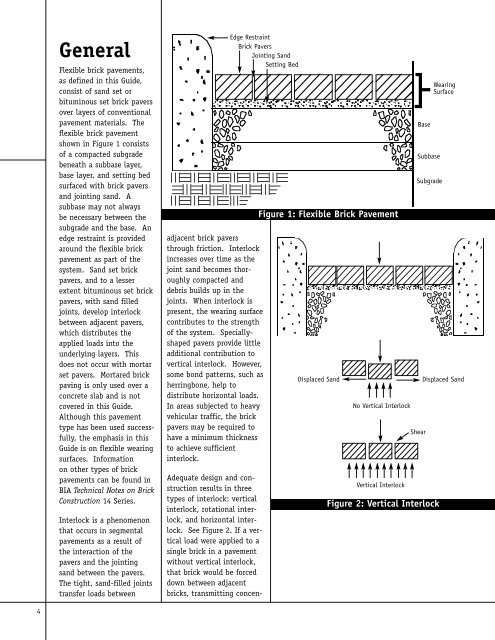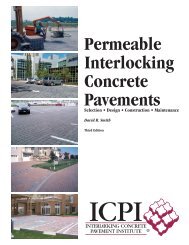You also want an ePaper? Increase the reach of your titles
YUMPU automatically turns print PDFs into web optimized ePapers that Google loves.
4<br />
General<br />
<strong>Flexible</strong> brick pavements,<br />
as defined in this Guide,<br />
consist of sand set or<br />
bituminous set brick pavers<br />
over layers of conventional<br />
pavement materials. The<br />
flexible brick pavement<br />
shown in Figure 1 consists<br />
of a compacted subgrade<br />
beneath a subbase layer,<br />
base layer, and setting bed<br />
surfaced with brick pavers<br />
and jointing sand. A<br />
subbase may not always<br />
be necessary between the<br />
subgrade and the base. An<br />
edge restraint is provided<br />
around the flexible brick<br />
pavement as part of the<br />
system. Sand set brick<br />
pavers, and to a lesser<br />
extent bituminous set brick<br />
pavers, with sand filled<br />
joints, develop interlock<br />
between adjacent pavers,<br />
which distributes the<br />
applied loads into the<br />
underlying layers. This<br />
does not occur with mortar<br />
set pavers. Mortared brick<br />
paving is only used over a<br />
concrete slab and is not<br />
covered in this Guide.<br />
Although this pavement<br />
type has been used successfully,<br />
the emphasis in this<br />
Guide is on flexible wearing<br />
surfaces. Information<br />
on other types of brick<br />
pavements can be found in<br />
BIA Technical Notes on <strong>Brick</strong><br />
Construction 14 Series.<br />
Interlock is a phenomenon<br />
that occurs in segmental<br />
pavements as a result of<br />
the interaction of the<br />
pavers and the jointing<br />
sand between the pavers.<br />
The tight, sand-filled joints<br />
transfer loads between<br />
adjacent brick pavers<br />
through friction. Interlock<br />
increases over time as the<br />
joint sand becomes thoroughly<br />
compacted and<br />
debris builds up in the<br />
joints. When interlock is<br />
present, the wearing surface<br />
contributes to the strength<br />
of the system. Speciallyshaped<br />
pavers provide little<br />
additional contribution to<br />
vertical interlock. However,<br />
some bond patterns, such as<br />
herringbone, help to<br />
distribute horizontal loads.<br />
In areas subjected to heavy<br />
vehicular traffic, the brick<br />
pavers may be required to<br />
have a minimum thickness<br />
to achieve sufficient<br />
interlock.<br />
Adequate design and construction<br />
results in three<br />
types of interlock: vertical<br />
interlock, rotational interlock,<br />
and horizontal interlock.<br />
See Figure 2. If a vertical<br />
load were applied to a<br />
single brick in a pavement<br />
without vertical interlock,<br />
that brick would be forced<br />
down between adjacent<br />
bricks, transmitting concen-<br />
Edge Restraint<br />
<strong>Brick</strong> Pavers<br />
Jointing Sand<br />
Setting Bed<br />
Figure 1: <strong>Flexible</strong> <strong>Brick</strong> Pavement<br />
Displaced Sand<br />
No Vertical Interlock<br />
Vertical Interlock<br />
Base<br />
Subbase<br />
Shear<br />
Figure 2: Vertical Interlock<br />
Wearing<br />
Surface<br />
Subgrade<br />
Displaced Sand



